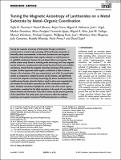Por favor, use este identificador para citar o enlazar a este item:
http://hdl.handle.net/10261/266177COMPARTIR / EXPORTAR:
 SHARE SHARE
 CORE
BASE CORE
BASE
|
|
| Visualizar otros formatos: MARC | Dublin Core | RDF | ORE | MODS | METS | DIDL | DATACITE | |

| Título: | Tuning the Magnetic Anisotropy of Lanthanides on a Metal Substrate by Metal–Organic Coordination |
Autor: | Parreiras, S. O.; Moreno, Daniel; Cirera, Borja; Valbuena, Miguel A. CSIC ORCID; Urgel, José I.; Paradinas, Markos CSIC ORCID; Ajejas, Fernando; Niño, Miguel Ángel; Gallego, José M. CSIC ORCID; Valvidares, Manuel; Gargiani, Pierluigi; Kuch, Wolfgang; Martínez, José I. CSIC ORCID ; Mugarza, Aitor CSIC ORCID; Camarero, Jesús Julio CSIC ORCID ; Miranda, Rodolfo CSIC ORCID; Perna, Paolo; Écija, David | Palabras clave: | Lanthanides Magnetic anisotropy Metal-organic networks Single atom magnetism X-ray magnetic circular dichroism |
Fecha de publicación: | 18-jul-2021 | Editor: | John Wiley & Sons | Citación: | Small 17(35): 2102753 (2021) | Resumen: | Taming the magnetic anisotropy of lanthanides through coordination environments is crucial to take advantage of the lanthanides properties in thermally robust nanomaterials. In this work, the electronic and magnetic properties of Dy-carboxylate metal–organic networks on Cu(111) based on an eightfold coordination between Dy and ditopic linkers are inspected. This surface science study based on scanning probe microscopy and X-ray magnetic circular dichroism, complemented with density functional theory and multiplet calculations, reveals that the magnetic anisotropy landscape of the system is complex. Surface-supported metal–organic coordination is able to induce a change in the orientation of the easy magnetization axis of the Dy coordinative centers as compared to isolated Dy atoms and Dy clusters, and significantly increases the magnetic anisotropy. Surprisingly, Dy atoms coordinated in the metallosupramolecular networks display a nearly in-plane easy magnetization axis despite the out-of-plane symmetry axis of the coordinative molecular lattice. Multiplet calculations highlight the decisive role of the metal–organic coordination, revealing that the tilted orientation is the result of a very delicate balance between the interaction of Dy with O atoms and the precise geometry of the crystal field. This study opens new avenues to tailor the magnetic anisotropy and magnetic moments of lanthanide elements on surfaces. | Versión del editor: | http://doi.org/10.1002/smll.202102753 | URI: | http://hdl.handle.net/10261/266177 | DOI: | 10.1002/smll.202102753 | Identificadores: | doi: 10.1002/smll.202102753 issn: 1613-6829 |
| Aparece en las colecciones: | (CIN2) Artículos (ICMM) Artículos |
Ficheros en este ítem:
| Fichero | Descripción | Tamaño | Formato | |
|---|---|---|---|---|
| Turning_the_magnetic_anisotropy_of_lanthanides.pdf | 1,81 MB | Adobe PDF |  Visualizar/Abrir |
CORE Recommender
Page view(s)
41
checked on 22-abr-2024
Download(s)
39
checked on 22-abr-2024
Google ScholarTM
Check
Altmetric
Altmetric
NOTA: Los ítems de Digital.CSIC están protegidos por copyright, con todos los derechos reservados, a menos que se indique lo contrario.
